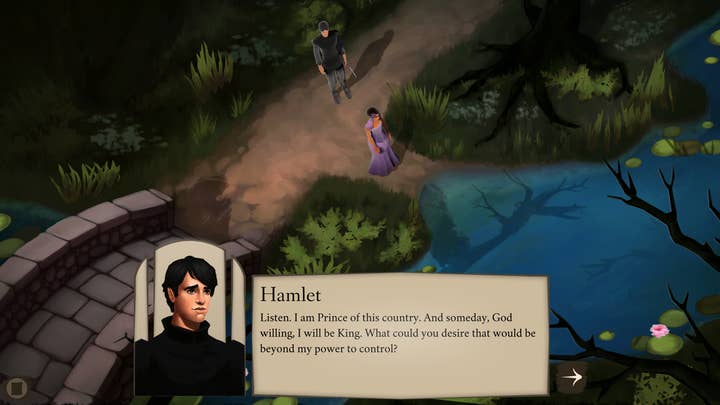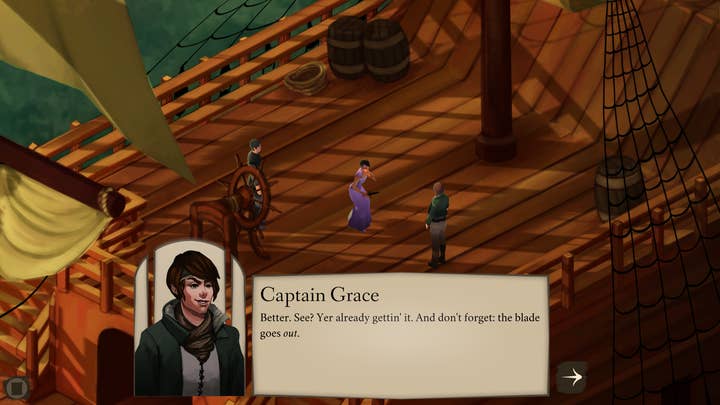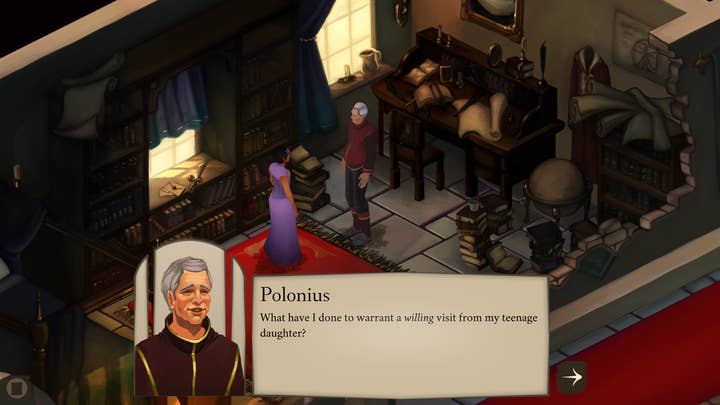In Elsinore, more matter is more art
Golden Glitch's Katie Chironis and Connor Fallon on the nearly decade-long challenge of making Shakespeare's Hamlet into a time loop video game
As one of the most famous works of Western literature, it's no surprise that Shakespeare's Hamlet has been adapted countless times across a wide variety of media. Even if you weren't forced to read the play in high school, you've likely read, seen, or heard (knowingly or not) at least one piece of media based on the tragedy at some point in your life.
And yet, it's very unlikely that said interpretation was a video game. Gaming adaptations of Hamlet over the years number in the single-digits. The most recent attempt, Golden Glitch's Elsinore, is being honored in the upcoming IGF awards with nominations for excellence in design and narrative, as an honorable mention for the Nuovo Award and the Seamus McNally Grand Prize.
Speaking to GamesIndustry.biz, team lead and writer Katie Chironis and designer Connor Fallon say that Elsinore was the natural byproduct of college Shakespeare courses, writing degrees, and a student game development club. The two met one another (and several other members of their eventual 11-person team) as part of the Game Creation Society at Carnegie Mellon almost a decade ago while Chironis was taking Shakespeare classes as part of a writing degree. They made a prototype of Elsinore during a game jam one year, scrapped it, then revisited it a year later and eventually turned it into a long-term project.
Golden Glitch, they tell me, was never a full-time studio. Rather, the group held onto its origins in the Game Creation Society as a sort of club, with its seven founders receiving no money until the profit share on the game's launch, and paying their four contractors out of salaries from their day jobs.
And the voluntary, off-hours nature of the project also ended up shaping how the studio's workers treated themselves and one another.

"Our game-making education was that club," says Fallon. "If you were making a game in your free time [in college], you were shipping a game in like six months, because they were all volunteer projects. You couldn't do two semesters because you wouldn't have the same people most of the time... So even when we started the full game, all the skills we learned in Game Creation Society like, 'Don't expect people to do stuff outside of meetings,' 'Meetings should be work sessions,' things like that, translated very well to Elsinore."
Chironis adds, "You can't crunch your team, because they're all volunteers and they will leave. You can't. If somebody is doing work that they're really unhappy with for a period of time, they'll just leave. So the onus on you as a project lead is to make sure everyone feels very cared for and loved. Which I think is a little bit different from programs where students are actually doing a game development degree, and they're kind of stuck in these project courses to get credit out of them.
"If somebody is doing work that they're really unhappy with for a period of time, they'll just leave"
Katie Chironis
"That was not the case here. People could bounce anytime. A lot of us did not know what we were doing. But we were trying. Any time one of us would go have an industry internship and then come back after the summer, they'd offer to teach us everything they learned from real game makers."
Chironis' desire to do a Hamlet adaptation was inspired by her high school English teacher, who she says made the work accessible and paired it with feminist theory and criticism of the work and its characters. That lens is evident in Elsinore, which tells the story of Hamlet through the eyes of Ophelia caught in a Groundhog Day-style time loop.
"If you want to have a story where somebody is going to save the plot of Hamlet, it can't be Hamlet, because Hamlet is so integral to the story of Hamlet that you take the spine out of it if he's gone," Chironis says. "So it had to be somebody who is not a hugely active participant in the original story, and Ophelia basically does nothing except show up few a few lines and then die. She does not have an active part in the in the original text. So that made her this stealth protagonist."

But this feminist reading of Hamlet doesn't stop at its protagonist. Elsinore also adds two additional women to the story and gender flips Rosencrantz and Guildenstern -- a marked diversity improvement over Hamlet's unaltered cast of 20 players with only two or three women.
"The primary reason was really just that Hamlet's original cast is a bunch of white dudes, and it just felt very, blah, like it was all going to blend together," Chironis says. "And I felt like even when Shakespeare was writing, Shakespeare was writing about queer portrayals of daily life and about people of color. He wrote Othello, and this was very much his life in the middle of London at one of the most explosive times in history. All of these social and political issues were all around him, and he did not shy away from them.
"I felt like even when Shakespeare was writing, Shakespeare was writing about queer portrayals of daily life and about people of color"
Katie Chironis
"So my thinking was if we're going to be putting the story into the modern age, and we're also going to be modernizing the language, why wouldn't we look at some of those same issues that Shakespeare cared about through that same modern lens?"
Chironis adds that they also opted to deviate from the usual audience expectation of Ophelia by making her a woman of color.
"We started out with her as the typical fair-faced maiden with blonde hair and blue eyes," she says. "And very quickly, we realized there's nothing in the original text which says that she has to be a white woman at all. So maybe there's an explanation. Her mother's never written about in the play. Her mother could have been anybody. Her father's too protective of her. She's a young girl, but there's not really any additional reason given why he's so overprotective. Maybe it's because she is a person of color in a world that really does not treat her with respect. And that is something that would make any father extremely protective of their child."
Of course, gender- and race-blind casting of Shakespearean work is hardly a new tactic across countless modern adaptations. But it's also not where Elsinore stops in its deviations from the traditional text of Hamlet. Because the game is a time loop where Ophelia tries to prevent the play's numerous tragedies, that necessitates giving her the ability to alter just about every plot event, creating new possibilities. Chironis and Fallon nonetheless emphasize that keeping the original plot intact was important to the player's understanding of what they were meant to do, though.
"Adapting Shakespeare to a game is fundamentally different from [adapting it to other media] because it's an additive act"
Connor Fallon
"Hamlet is the default timeline," Fallon says. "The one where you stand in the corner and don't do anything."
However, he continues, Elsinore's very nature as a video game meant that Golden Glitch had to balance respect for the original text with a lot of inventiveness about where the story could go.
"Adapting Shakespeare to a game is fundamentally different from [adapting it to other media] obviously because of interactivity, but also because it's an additive act," he says. "If you're making a film based on Hamlet, you have to condense it unless you want the film to be four hours long. But what was interesting about Elsinore was peeling back the curtain and seeing what people are doing off-screen. I think there's room for a lot more adaptations of that nature."

One of the ways that Elsinore manages to peel back so much of Hamlet's curtain is through its time-loop structure. Though time loop games seem to have hit their stride in the last few years, Chironis says that aside from Majora's Mask, there weren't really many good examples when they first began working on Elsinore in 2010. Rather, the team took inspiration from anime and visual novels, which she says use the trope far more often. And naturally, they believe games can use the structure to do interesting and inventive things that linear games can't manage.
"It was really nice to build a game where understanding people is where your power comes from"
Connor Fallon
"Time loops solve a lot of design problems really well," Fallon says. "Especially for narrative games, if you have crazy branching, you're making all this content that people aren't going to see because they go down one branch, and then they don't even know that this other stuff existed. And time loops kind of make that part of the core loop. You can have the story go everywhere, because that's the whole thing. In having a constrained amount of time, the player can explore all these different possibilities versus just experiencing one possibility among many."
Chironis continues, "We wanted to treat these people as fully fleshed out human beings who are capable of both incredible good and incredible evil. And when you're put into a pressure cooker of a situation with pending, massive family trauma and a literal ghost, you run into this situation where the difference between somebody being your best friend or your lover or your worst enemy or your murderer is a hair of a difference in what they know and believe and how they feel.
"If somebody decides to try and murder you in a linear game, you have to have them go through all these emotional states where they're your best friend, and then they're a villain, and that would take hours and hours. But if you do it in a time loop game, you can have somebody come after you in a violent rage. And then you learn something about them. And then in the next loop, you can come in and use that piece of information to soften them and get to know them and become their friend and see this totally different side of them.
Fallon concludes, "You get to the end, you learn some key thing, and you wake up at the beginning again, and that's a very natural progression loop to explore weird possibilities that cause you to learn new things that allow you to unlock other possibilities. It was really nice to build a game where understanding people is where your power comes from. Where the more you know about people, the more ability you have to change the story."









